RUG TIPS
***
COMMON
AREA RUG PROBLEMS
Abrash or Color Variations in Rugs
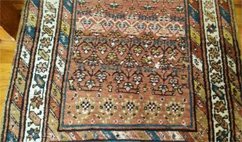
Authentic oriental rugs, by their very nature, have many variations because they are handmade rather than machine-made. This hand manufacture results in certain distinct, beautiful, and unique characteristics that set oriental rugs apart from lesser reproductions.
Rugs made by hand will always have certain variations in their surface coloration, the density of hand-knotting of the pile, irregularities in shape along the edges or borders, and differences along the fringes or fringe ends.
One of the most common and typical characteristics of a genuine oriental rug, and especially among older or 'nomadic' rugs, is the beautiful color variation known in the trade as 'abrash'.
The effect of abrash is to create or produce differing color patterns, colorations, and various shades or hues. Gradations can often be seen within one color or color field in the design, such as the blues, reds, browns or other colors. These variations may appear as bands or horizontal bars, but other shapes or sections of color variation are possible. Abrash coloration can vary from very subtle shade differences to distinct or even bold variations in certain colors of the rug.
Abrash results from differences in the dyeing process. Small quantities of skeins of pile yarn are dyed by hand before the rug is made. Each dye lot is hand-knotted into the rug, but when another dye lot is next used some color variation is inevitable. Connoisseurs of antique and semi-antique oriental rugs value the beauty and handmade appearance that is typical of abrash.
Sometimes abrash color variation is covered over or obscured by soiling and compaction of the rug pile with use and wear. When the rug is cleaned, much surface soiling is removed, and the pile is groomed and made more erect. The truer and authentic pile coloration is now revealed, along with some abrash color variations that were there at the time of manufacture. In addition, there is a possibility that slight variations in pile direction or 'shading' will also be seen after a thorough cleaning. One or both of these effects show up as color variations in the rug.
These distinct colorations are not defects at all but are characteristic of the many variables and dye lot differences that went into the original handmade rug. Indeed, some of the highest quality rug manufacturers spend a lot of time and money simulating this abrash in their machine-woven rug designs. Abrash is part of the beauty and distinctive natural appearance of hand-made oriental rugs, and even of some machine-made rugs which try to reproduce real abrash.
Dye Bleeding
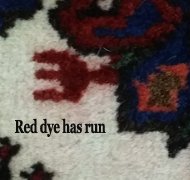
Dye bleeding occurs when a colored fiber loses dye while wet. Uncolored or light colored fiber or yarn may readily soak up fugitive (runaway) dyes from the darker fiber or yarn and become stained. This is most often seen in rugs and carpet where deeply dyed shades (for example, reds, blue, blacks) become fugitive and bleed into white or light-colored areas.
At least two conditions cause dye bleeding in colored fibers and yarns:
- Defective dye or dyeing method. In such a case, the dye is either poorly selected or not properly handled during manufacture. The result is excess, unsecured, weak, and/or unstable dye. When a dye with poor stability or wash fastness is used, it may bleed during or after the first few cleanings. Likewise, when too much dye is used during manufacture, the excess adheres near the outside of the fiber where it may readily wash away. Such defects in dye or dyeing method, at the time of manufacture, produce a textile product which is defective. Unfortunately for the consumer, these defects are not visible at the time of purchase.
- Dye is affected by use. This is the second condition. Sunlight, atmospheric fumes, common chemicals, animal/pet residues, etc. can weaken dyes over time. Once dyes are weakened, they may run or bleed with cleaning.
If pretesting or experience does not indicate a potential dye bleeding problem, the rug cleaner should not be held liable for using what would otherwise be usual and customary cleaning procedures. The best guarantee of satisfaction is to use our services at ABC. We use our experience and stand by our service as a reputable cleaner.
Flatwoven Rugs
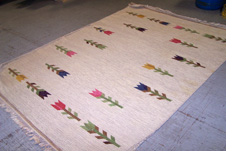
Flatwoven rugs, or 'flatweaves,'" comprise numerous types of rugs with names such as aubusson, berber, dhurrie, drugget, kilim (or kelim), Navajo, rag rug, soumak, and Zapotec.
These rugs are usually handwoven in a tapestry-like construction and have a flat surface without a distinctive raised pile. Many flatwoven rugs are reversible.
Currently, the most popular flatweave types are the dhurries with cotton or wool face yarns, kilims with wool face yarns and rag rugs made of cotton or polyester fabric scraps. Dhurries traditionally are woven in India and Afghanistan. Kilims usually are woven in Turkey but are also produced in other countries. Rag rugs are woven in many countries, including the United States.
These popular rugs provide excellent service, along with good value and a pleasing appearance. Unfortunately, they also characteristically exhibit some problems when cleaned.
- Irregularities in Weaving. The warp, or lengthwise yarns are generally cotton in most flatwoven rugs, although they may be wool or occasionally, silk, in older or finer rugs. These lengthwise yarns are hand-wound onto the loom before weaving. Irregularities in warp and weft positioning and tension and weave structure appear in woven goods from even the best weavers. Additionally, there may be a range of variations in yarn twist and diameter. Cleaning reveals these inherent irregularities (which may or may not be visible before cleaning) in the form of curling, rippling, striping or buckling in the rug. The sides or edges of these rugs are especially prone to curling.
- Weaver Markings that May Bleed. Some flatwoven rugs may have pattern markings placed on the warp by the weaver. These are usually marked with colored chalk or ink (red, blue or black) to aid in the weaving. The markings are completely hidden as the rug is woven, but since the markings are seldom colorfast, they can bleed during cleaning. Since the cleaner has no way of predicting this inherent problem in advance, it is not the cleaner's fault.
- Dye bleeding or Color Run. The yarns on the surface of the rugs are sometimes bright, bold colors that may bleed when cleaned. We take precautions to avoid this condition by using the most appropriate cleaning techniques. Despite cautious handling of such rugs, there is some unavoidable risk of dye bleeding (or color run) after cleaning. It may not be possible to remove dyes which have bled. This problem is linked to poor dye selection and improper dyeing and handling during manufacture. In addition, most dyes are weakened by age, exposure to sunlight, atmospheric fumes, pet urine and spills, etc., all of which contribute to dye bleeding before, during and after cleaning.
- Fraying Fringes. Many flatweaves have fringes that are continuations of the warp yarns which are part of the rug's weave structure. All fringes fray and darken with age and dirt. Only special chemical treatment can lighten the fringe color.
- Limited Cleanability. Flatwoven rugs have limited cleanability because their flat surface readily shows soil, dirt, dust, spills, and stains. Many dhurrie rugs are designed in pastel colors and thus always appear to be more soiled than darker rugs. Flatwoven rugs should be vacuumed regularly and cleaned more frequently than other rugs. Application of some type of stain protection may be advisable.
Rug Fringes
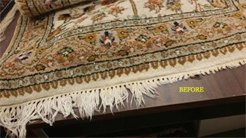
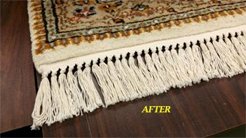
The cleaning of Oriental and area rugs is a complicated and intricate process. A major concern during this process involves the rug fringes. Rug fringes are prone to some deterioration with normal use due to the fiber content of the fringes (usually cotton), their loose or low twist and their open ends. These characteristics make rug fringes susceptible to untwisting and texture loss during normal use such as vacuuming, walking, etc.
There are additional reasons why fringes may require special treatments during or after cleaning. The first reason is cellulosic browning. Rug fringes are mostly made of cotton, a cellulosic fiber, which undergoes natural changes with time. These changes may lead to the development of a brown stain or discoloration called cellulosic browning. The second reason is the possible change in the color of the fringes during cleaning. This form of color change often occurs as fugitive dyes from the wet rug are being absorbed by the fringes.
There are 2 ways to clean or re-clean rug fringes:
- The first approach is re-cleaning the fringes by hand, with or without mild acid, rinsing and rapid drying with a blower.
- The second, a stronger treatment, involves bleaching, with or without rinsing, and rapid drying.
If browning or color bleeding is severe, it may not be eliminated by the first approach (the milder treatment). The second approach will result in white fringes but may also cause some physical deterioration of the fringes. This deterioration is generally manifested in their strength loss, fiber loss and/or "stringy" texture.
Each procedure has its advantages and disadvantages. The first treatment does not weaken the fringes but may leave them off-white or slightly discolored. The bleaching process will whiten the fringes but may result in a change in texture of the fringes. The fringes may also look stringy and break off during subsequent vacuuming and wear. The choice of procedures best suited for a particular rug comes from knowledge and experience.
Eventually, all rug fringes will wear out from normal use and care. We can renew the appearance of your rug by replacing or re-fringing the old, worn rug fringes. All rugs coming into our plant are checked for possible repair needs. Our repair specialists will be happy to give you an estimate if you desire.
Latex Decay
If your rug has a backing, it is very likely a machine-made rug, not an oriental or handmade rug. This backing is applied by the rug manufacturer (carpet also) with latex, an adhesive material. The latex is used to anchor tufts to the back, give additional weight and to hold the backing onto the rug.
Tufted rugs are a good example of this kind of construction. These rugs are often confused with handmade rugs and may even be labeled as 'handmade.' Actually, the tufting may be done by hand, but it is done with a tufting gun held by the employee's hand!
Tufted rugs, especially those from India, can also have an odor of 'burning rubber.' This odor may not be apparent in a large department store but may be very offensive in a consumer's home. The odor cannot be removed by any cleaning process. In the country of manufacture, the latex is not given a chance to cure completely before it is shipped to other countries. It will pick up diesel fumes from the shipping vessel and they are forever trapped in the latex. Once you realize that you have purchased one of these rugs, take it back to the store and you should receive your money back. If not, please contact our office for more information.
Because of the nature of the latex or glue in tufted rugs (and other rugs with backings) and its ability to trap odors, we cannot guarantee complete urine odor removal from these rugs.
Latex starts to deteriorate as soon as it is put into service, similar to the rotting of automobile tires, elastic bands in garments and rubber bands. The breakdown is caused by gases in the air, floor waxes, traffic, and sunlight.
A complex mixture, latex contains many chemicals, affecting both its wear properties and cost. Chemicals are added to latex in an effort to retard this breakdown but cannot prevent it from taking place.
Other chemicals are added to reduce cost. Such chemicals could be compared to gravel in a concrete mixture. They take up space but have no adhesive properties. Increased use of this material reduces the adhesive power of the latex, causing an earlier breakdown and therefore, a separation of the backing from the rug.
The more expensive latex compounds will better withstand aging as well as cleaning, but even these will deteriorate eventually. The rate of deterioration is influenced by the ingredients of the rubber mixture as well as the conditions under which it is used. This breakdown will not take place evenly but will appear in smaller areas in the form of 'bubbles' or separation. In many cases, it is more apparent along the rug edges exposed to gases in the air.
This condition can also occur in carpets. Please click here for more information about backing separation in wall-to-wall carpets.
Please also see Odors & Color Problems in Area Rugs directly below.
Odors & Color Problems
in Area Rugs
- Odors. In recent years there has been a profusion of lesser quality, odorous area rugs that have appeared in the consumer marketplace. Most of these are hand-tufted rugs from the Asian subcontinent, particularly imported from India, Pakistan or China. One of the common problems with these rugs is a tenacious unpleasant odor that emanates from the latex back coating or adhesive which is part of the carpet construction. Unfortunately, this foul odor is 'built in' and no amount of professional cleaning or deodorization will permanently remove it. New rugs should never smell this way, and good, old rugs seldom do either. The odor can vary from mild to strong and oppressive. One characteristic smell typical of these rugs is of 'diesel fuel' or 'burnt' oily type residues coming out of the latex. These rugs may even smell bad right in the store, but the odor appears more concentrated and noticeable in the smaller rooms and spaces of your home. The mass market importers often sell these shoddy rugs and this foul condition is a defect in the rug from manufacture and distribution. Area rugs with this foul odor problem usually have wool pile fiber but could also be acrylic, cotton, olefin or others. The construction has the pile inserted through a primary backing and latex 'glue' or adhesive applied to the underside of the backing fabric to help secure the pile yarns in place. Also, this same latex adhesive is used to glue or adhere the secondary backing fabric to the rest of the rug. The secondary backing fabric, usually a coarse cotton duck fabric and often dyed green, blue or other colors, is what you would see when looking at the back or underside of the rug.The odor may be caused by defective, low quality latex adhesive used at the time of rug manufacture or not enough time allowed to 'cure' the latex before the rug is shipped to overseas markets. There may be diesel oil odors absorbed into the latex during shipboard transport from India or the odors used to cover up other problems. The cleaning industry's best experience is that this offensive odor cannot be permanently removed and may or may not be temporarily alleviated.
- Color Problems. In addition, there are discolorations and dye transfer problems associated with Indian or lesser quality Asian area rugs that further compound their defective nature. When these area rugs with dyed backings are placed on top of light color carpet, the poorly dyed cotton scrim or canvas backing fabric may 'crock' or transfer its green, blue or other color onto the carpet or rug underneath. In addition, during wet cleaning, fugitive dye marks used to stencil the pattern for hand-tufting can bleed up to the surface of the rug pile. With cotton hooked rugs, discoloration from cellulosic browning can occur during cleaning and drying. Some of the darker colors can bleed during cleaning. None of these offensive conditions should ever occur with a well-made oriental or area rug. As noted above, it is our professional opinion that such rugs are fundamentally defective, either due to the persistent foul odor and/or the dye transfer, discoloration or color bleeding, and should be returned to the retailer.
Painted Rugs
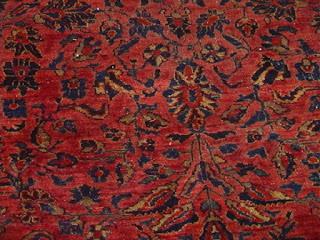
'Painting' of both new and old rugs has become epidemic. The problems with painted rugs are many and the consumer needs to be informed of the consequences. First, if the paint is not washfast (and it usually isn't), the rug will be prone to subsequent color bleeding during professional wet cleaning. Second, the painting is often used to cover over worn areas, but this is not disclosed to the customer. If the painting is in fact disclosed, then the buyer should pay a fair price for the painted rug.
Why do some dealers or retailers paint over oriental rugs, whether worn or new? One common scenario is to hide worn areas of an older rug where the foundation has become exposed. Using dye markers, colored inks, water or solvent-based tints, the lighter colored worn areas where the foundation is exposed are 'tinted' or colored over in an attempt to match the original pile color and disguise the wear.
This surface painting or tinting is quicker and less expensive than re-knotting or inserting new pile, which is the proper way to restore a worn area or missing pile. By merely painting over the wear spot, these worn areas will quickly return to their prior faded appearance during use by the customer.
A second and more serious problem, however, is that the surface painting will often bleed into surrounding areas of the rug when liquids are spilled or when the rug is washed. Many of the surface colors, when overpainted, are not washfast and can bleed profusely, even with the best of professional cleaning and care.
Some newer oriental rugs are also painted, either on the back or on the face (pile side). New rugs from India and Pakistan are sometimes 'painted' on the back (or underside) of the outer border or fringe. When painted, the colors in the outside border are typically black, dark blue, red or kelly green and these colors are prone to bleed or color run when wet.
Other reasons for painting the pile of oriental rugs, even though new or not noticeably worn, is to enhance surface colors and/or to eliminate color variations. These variations are known as 'abrash.' Though normal or pleasing to most, abrash coloration may be disliked or misunderstood by buyers and thus some dealer decides to 'paint' over this special effect.
But how can you know if the rug you've purchased or are considering to buy has been painted? First, ask the dealer or retailer several related questions:
- Has the rug ever been tinted or painted over and how do they know one way or the other?
- Ask if the dyes and rug coloration are guaranteed to be washfast, i.e., can the rug be safely wet-cleaned? They may assure you it can, even when it cannot, so get the assurance in writing.
- You should also inquire if the dyes are natural or synthetic in origin. Naturally-dyed rugs are often more aesthetically pleasing (and more expensive), but your main concern should be "Are they color fast?" That is, are the dyes and colors resistant to premature light fading and to color bleeding when wet?
Some naturally- dyed rugs (and certain painted rugs) may have excellent color fastness but many others do not. If the dyes are not 'fast' or secure and the pile has been 'painted', then the rug cannot be successfully washed and adequately cleaned.
The best way to determine wash fastness is the simple Turkish towel test which follows: Moisten a white (or Turkish) towel with tap water and then rub or blot persistently on all colors. Do this on both the face or pile and on the back where appropriate. If any color comes off or transfers onto the towel, it is indicative of a latent color bleeding problem that can cause serious problems later.
Testing the colors on the surface or pile applies to both new and old rugs. If any color transfers or would appear to bleed during the test, then do not buy this rug. We cannot recommend buying a 'painted' rug or any rug that is not colorfast.
Dealers selling painted rugs are not the most trustworthy. So if you're not assured or confident about the purchase, then avoid it and look for another rug or rug dealer, or both.
'Painted Sarouks' (as in the image above) are a particular type of oriental rug imported from Iran that has distinctive rose fields with blue borders and detached floral motifs. Unfortunately, the finishing process used in the early to mid-part of the 20th century had a tendency to fade the rose color. A New York merchant, certain that the American buying public would prefer the darker color, applied a unique solution to this problem by supplying workers with small paint brushes and synthetic dyes. Armed with these, they applied a rose color, painstakingly by hand, to many thousands of these rugs over a period of about 20 years. These are aptly called 'American Sarouks.'
These America Sarouks can still be found today. More often than not, their painted-on colors have become mottled and uneven though an occasional one may be perfectly preserved. Once you have seen one of these rugs, you won't forget it! The easiest way to tell that a rug is a painted or American Sarouk is to look at the colors in the field on both the front and the back. If the field on the front of the rug is dark rose or burgundy and the field on the back is light rose, you have an American Sarouk. Many consumers of oriental rugs find the mottled appearance of American Sarouks to be pleasing to the eye.
Ripples in Rugs
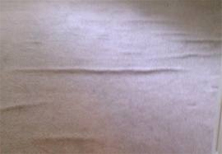
If two adjacent areas of a carpet or rug are not manufactured under the same amount of tension, unevenness or rippling can develop.
Each case of rippling is different. For area rugs and oriental rugs this situation can sometimes be corrected by wetting the backing and tacking the rug out in a stretched position. However, the ripples may recur when moisture is again present.
Rippling can also occur in wall-to-wall carpet, known as backing separation. Click here for information.
Silk Textiles
Silk fibers are being used increasingly in textile furnishings such as rugs, upholstery, and draperies. Silk is a luxury fiber used in the manufacture of expensive, high-fashioned products. It can be dyed and printed to produce very beautiful designs and bright shades. These properties make silk a beautiful, very desirable fiber.
Silk also characteristically exhibits several problems when cleaned. The following problems often are revealed or accentuated by normal cleaning:
- Silk dyes may be soluble (dissolve) in water, detergent, and/or dry cleaning solvent.
- Silk is also prone to color bleeding and the formation of water spots, ring marks or perspiration stains. Color bleeding is more of a problem with dark colors than with pastels.
- Being delicate, silk is susceptible to abrasion, yarn slippage, sunlight damage, discoloration, and can show texture changes.
In order to minimize the problems described, special procedures are required for cleaning silk. The choice of method depends on various factors such as the age and condition of the silk textile, spots and stains present, and consumer expectations.
In general, it is more prudent to dry-clean silk. Though some silks can be wet-cleaned successfully, and wet-cleaning of silk aids soil and stain removal, it may result in texture distortion, which is often permanent.
It is important to remember that more intensive cleaning is usually required to restore the appearance of an excessively soiled rug or fabric. Such thorough cleaning procedures, however, have a higher propensity to cause damage.
Silk textiles, therefore, should be maintained well (vacuumed regularly) and cleaned more frequently, before they become excessively soiled.
It is also advantageous to use silk textiles prudently. For example, use silk rugs in areas with no foot traffic (as wall hangings) or at least, limit the amount of foot traffic on them.
Textile Insects
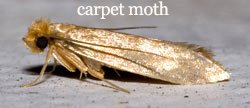
Carpet beetles and moths still abound, even with the popularity and widespread use of synthetic fibers. Clothes moths and carpet beetles can digest protein fibers such as wool, silk and specialty hair fibers, but they can also be found on synthetic fibers if they contain protein substances, such as food or beverage stains, blood, urine or other sources of nutritional protein.
Firebrats and silverfish are also textile pests that attack carbohydrates.
Termites digest cellulosic materials including yarns made of jute and cotton.
Fleas lay their eggs in rugs and a professional cleaning of a rug that is flea-infested in our plant will completely eliminate the fleas as well as their eggs. Eliminating fleas from wall-to-wall carpets in the home and business environment is discussed in Textile Insects Carpet Tips.
For information on removal of dust mite infestations and pet allergens, please see Anti-Allergen Green Cleaning for Dust Mite Allergies and Anti-Allergen Green Cleaning for Pet Allergies on this website.
The most effective way to prevent an infestation from textile insects and inhibit growth is to keep textile furnishings clean. Spills should be removed immediately. Rugs should be brushed or vacuumed regularly as insects do not generally attack clean materials.
Regular cleaning will remove the nutritional contaminants that can attract and support insects. If an infestation has occurred, please call our office so we can explain our process for treating textile products for insect control.
Please note, if an infestation is severe, a call to a licensed pest control operator may be required.
"The Cleanest Clean You've Ever Seen."
by
ABC Oriental Rug & Carpet Cleaning Co.
130 Cecil Malone Drive Ithaca, NY 14850
607-272-1566
TABLE OF CONTENTS


